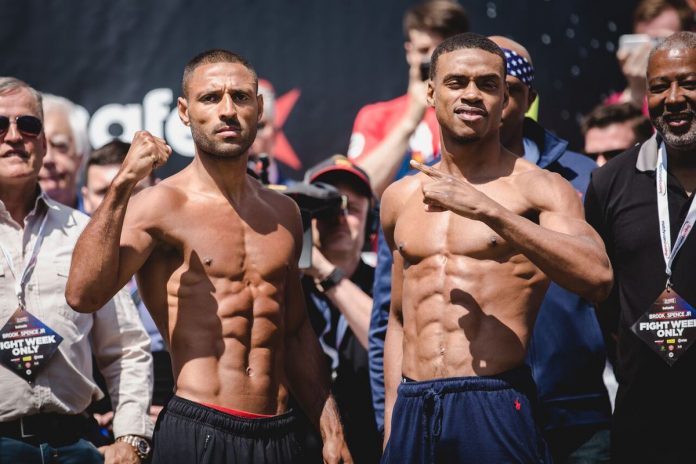Oh to be a heavyweight, where the worries of body fat percentage and making weight don’t exist. The likes of Anthony Joshua can eat what he likes without having to be obsessed by what the scales are saying. For everyone below that weight though, trying to find your optimal fighting weight and right body fat percentage is a daily struggle that can take the enjoyment out of the game.
There is point where your body reaches its optimal fighting weight. There is a reason that you don’t see smaller fighters with huge biceps fighting against taller fighters with smaller muscles, and that’s because boxing is a lot more than the ability to lift weights. The same goes for body fat too, if a boxer slims themselves down too much then they risk not being at 100% for their bout.
This was seen by Kell Brook over the course of two fights. He decided to step up from 147lbs to 160lbs in order to fight Gennady Golovkin. To make extra use of the weight, he bulked up and increased his body fat percentage and also increased his muscle mass. That extra weight sounds great, but for every ounce of fat or muscle that your body has, it is extra weight that is has to carry and give energy to. The theory would be that a boxer could punch harder, but the fact is that he won’t be able to punch as quickly and his energy reserves will deplete sooner.
Understanding The Science Behind A Lean Boxer
Let’s get scientific for a moment and talk about Isaac Newton’s Second Law of Motion which states that ‘Force = Mass x Acceleration’, which makes sense, especially when it comes to boxing punches. The higher the mass (body fat and muscles) the less acceleration (speed of the punch) meaning the overall force doesn’t change. This also applies to footwork, the heavier you are, the slower you’ll be.
It didn’t work for Kell Brook vs Golovkin, as his opponent was fighting at his perfect weight. The thudding of his shots was too much. His muscles may have been as big as Brook’s, but he had the bigger body to carry them with extra power. The flipside of this was found in Brook’s next fight as he went back down from 160lbs to 147lbs in order to fight Errol Spence.
He had to shed that extra muscle mass and also massively cut down on his body fat percentage. The body requires a bit of fat in order to properly function, but trying to keep it low can also lead to other issues. Getting down below your natural fighting weight can deplete your body of the resources it needs. Everyone knows you need food for energy, and cutting weight can leave you without much energy to be able to compete.
Against Spence it was clear that Brook was no longer a 147 fighter, and has since moved up in weight classes to 154lbs, which he will now call home. Whether fighting Golovkin or Spence at 154 would have made much of a difference is up for debate, as they are world class fighters and Brook’s eye issues were obviously a huge problem. It does though highlight the problems boxers can have with their weight and how hard it can be to find the perfect body fat percentage to box at.
Striking The Right Balance

Clearly there is a balance to be struck, even heavyweight boxers are at their best when they have a low body fat percentage. All the current title holders carry a low body fat percentage into a fight, and even Tyson Fury who has fought heavy in his past fights knows the advantages of slimming down. For a heavyweight though, there is no optimal percentage as there comes a point where fitness is a lot more important.
Anything below the 5% body fat figure could be considered dangerous, and is definitely not conducive to strong athletic performance. It is the kind of figure that is only ever achieved by models and bodybuilders who are aiming for their bodies to ‘look good’ above anything else. If you had a body fat percentage of 3% and tried to get through a 12 round bout, you would struggle greatly.
The average healthy male would have a body fat percentage around the 20% figure, which shows the dramatic difference between what is considered normal and what is dangerously low. If you didn’t know anything about body fat percentage before, you may be surprised that the healthy amount is so high, but as said, fat is an essential part of keeping your body healthy. When taken it in the right amounts, your body uses it for warmth and insulation of vital organs.
For women, the figures are slightly higher as female bodies require a higher body fat percentage to function. Where a figure of 20% would be considered healthy for a man, a figure of 25% would-be completely fine for a woman. The same applies for female boxer in trying to make weight, trying to get down to a single digit figure can be dangerous and inhibit performance.
Again, this is why finding the right weight to fight at can be so crucial. If a boxer is at too low a weight, then they could end up trying to get rid of fat that they simply don’t have. You can only dehydrate yourself so much, and if you still have a few pound to lose before the fight, then you’re either going to miss weight or treat your body dangerously in order to do so.
How Does Boxing Compare?

So where should boxers fit in? Well to look at this then maybe it’s best to look at the average male percentage for a selected few other sports
- Baseball 12-15%
- Bodybuilding 5-8%
- Cyclists 5-15%
- Gymnastics 5-12%
- Sprinters 8-10%
- Swimming 9-12%
- Tennis 12-16%
Here we see athletic sports such as tennis where their body fat can be a lot higher due to the fact that weight plays very little part in how they can perform. Tennis players can just focus on being the fittest they can be to get through those gruelling five set matches. If boxers didn’t have to make weight classes, then this is where you’d say the best place to be and would most likely be the same range for most team sports where fitness is the only concern.
We see the difference in sports where weight does play a part that the minimum range is a lot lower. In long-distance cycling it’s important that your weight is as low as possible so that it takes less effort to carry your body and your oxygen isn’t wasted. This is why you have two distinct body types in cycling, your long-distance specialists like Chris Froom are long and thin with very little muscle mass, and sprint cyclists like Chris Hoy generally have a much wider build with huge leg muscles.
Long-stance cyclists and gymnasts don’t have to worry about power however, and only have to focus on having the strength to carry their own bodies. Boxers do have to worry about power, and having that slender frame like a Chris Froome would never work in the ring.
There is a clear comparison in the list and that is with sprinters. They have to rely on power, but also want to ensure that they are as light as possible so none of that power is wasted. Where a sprinter will have all that power in their legs, boxers obviously want it in their shoulders and their arms. A body fat percentage of 8-10% would seem like the ideal point for a fighters and this is more than likely where those who healthily make weight lie.
Those that struggle to make weight would probably between the 5-8% scale which, while possible, isn’t healthy in the long-term as the sacrifices you have to make to get your body to achieve that level while still taking punches is a lot for your body to take. With lean heavyweight boxers such as Anthony Joshua, they are most likely more on the tennis side of the scale with a body fat percentage of over 10%.
The Right Way To Lose Weight

The right amount of fat in your body can be a delicate balance, and your body is very wary when it comes to what you are doing with it. There is two ways that your body can make energy once its stores of food run out. One is by burning fat to run your body, but the problem comes if your body thinks that its stores of fat may be running too low, as it can also burn muscle.
That’s why, even with making weight, it’s important to eat the right food so that your body doesn’t start to panic. Boxers need that muscle mass and there is a reason they can’t healthily reach a body fat percentage of 5% or below. A basic set of scales can’t tell the difference between the loss of fat or muscle, but there are body fat specific scales on the market which are a good gauge for your current levels, we recommend these FDA approved scales on amazon.
As people get older, their body fat percentage will likely increase as they age, making it harder for fighters to consistently make the same weight that they always did. That’s part of the reason that fighters generally move up the weights as they go through their career. It’s important for boxers to find the right point and change weights at the right time. As mentioned the likes of Kell Brook realised that he could no longer make 147 without depleting his body in the process.
You may wonder why some boxers don’t just abandon making weight, and just fight at a level that feels comfortable to them? Fat obviously hinders performance and in a sport where fitness is required at an elite level, it can make all the difference. Whenever a boxer makes a huge jump up in weights, it almost never ends well. It’s almost impossible to name a world-class boxer who was overweight. While for the heavyweights they can get away with it due to the slower speeds at the top, you only have to look at the best ever in their prime.
Ali, Tyson, Louis, Foreman, Marciano, Lewis, Frazier . . . the list goes on. You only have to see how those fighters looked like in their prime. They were lean fighting machines who didn’t want any excess fat to take away from their speed. A few of those fighters ended up a lot heavier, but they had long passed their best. That added body fat is dead weight which will not only limit speed and movement, it is also extra energy that your body has to burn. This is why you never see a successful boxer overweight.
Check out the video below for a helping hand on your way to the bodyfat percentage you’re after!
So, Is There A Perfect Percentage?
Well it’s impossible to gauge an exact universal figure. Not only do age and gender make huge difference to the level of body fat you should have, but there are also other factors such as body shape which can play a role, especially with women. For a boxer, it’s important to find the perfect balance to find out which body fat percentage, and weight, will provide the best performance.
Some level of body fat is essential and for men they require at least 3% to full function and protect their organs. There is a level above that where you want peak athletic performance, and that is where the extra fat is required for a boxer. Fat may generally be seen as a bad thing, but I think most people also appreciate that everything in a balanced diet has some use, just as carbohydrates are vital for energy.
For a male boxer, 8-10% would be the ideal range and for women it will be around 12-20%, as females require a lot more essential fat for the healthy running of their bodies. Those kinds of figures will hopefully help you not feel downhearted when you look in the mirror. Next time you see a boxer at a weigh-in, just remember that a whole 10% of that body is likely to be fat.






![5 Best Boxing Gloves for Kids [Our Guide For 2022] best boxing gloves for kids](https://boxingready.com/wp-content/uploads/2019/06/best-boxing-gloves-for-kids-150x150.jpg)






